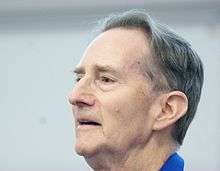Peter B. Andrews
Peter Bruce Andrews (born 1937) is an American mathematician and Professor of Mathematics, Emeritus at Carnegie Mellon University in Pittsburgh, Pennsylvania,[1] and the creator of the mathematical logic Q0. He received his Ph.D. from Princeton University in 1964 under the tutelage of Alonzo Church.[2] He received the Herbrand Award in 2003.[3] His research group designed the TPS automated theorem prover. A subsystem ETPS (Educational Theorem Proving System) of TPS is used to help students learn logic by interactively constructing natural deduction proofs.

Peter Andrews in 2012
Publications
- Andrews, Peter B. (1965). A Transfinite Type Theory with Type Variables. North Holland Publishing Company, Amsterdam.
- Andrews, Peter B. (1971). "Resolution in type theory". Journal of Symbolic Logic 36, 414–432.
- Andrews, Peter B. (1981). "Theorem proving via general matings". J. Assoc. Comput. March. 28, no. 2, 193–214.
- Andrews, Peter B. (1986). An introduction to mathematical logic and type theory: to truth through proof. Computer Science and Applied Mathematics. ISBN 978-0-1205-8535-9. Academic Press, Inc., Orlando, FL.
- Andrews, Peter B. (1989). "On connections and higher-order logic". J. Automat. Reason. 5, no. 3, 257–291.
- Andrews, Peter B.; Bishop, Matthew; Issar, Sunil; Nesmith, Dan; Pfenning, Frank; Xi, Hongwei (1996). "TPS: a theorem-proving system for classical type theory". J. Automat. Reason. 16, no. 3, 321–353.
- Andrews, Peter B. (2002). An introduction to mathematical logic and type theory: to truth through proof. Second edition. Applied Logic Series, 27. ISBN 978-1-4020-0763-7. Kluwer Academic Publishers, Dordrecht.
gollark: You see, this is designed to produce *infinite* computers. Glass and stone are easy. But computers need redstone.
gollark: It's about the right size.
gollark: No it's not.
gollark: Here is our computer factory.
gollark: It's for a project on CodersNet to provide cheap computers to all! GTech partnered with "Microsoft".
References
- "Peter B. Andrews". gtps.math.cmu.edu. Retrieved 2018-03-10.
- "Alonzo Church - The Mathematics Genealogy Project". www.genealogy.math.ndsu.nodak.edu. Retrieved 2018-03-10.
- Andrews, Peter B. (2003-10-01). "Herbrand Award Acceptance Speech". Journal of Automated Reasoning. 31 (2): 169–187. CiteSeerX 10.1.1.69.5121. doi:10.1023/b:jars.0000009552.54063.f3. ISSN 0168-7433.
This article is issued from Wikipedia. The text is licensed under Creative Commons - Attribution - Sharealike. Additional terms may apply for the media files.